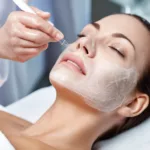22 November 2023
Dr. Lacey Anderson sheds light on the transformative effects and precautions of chemical peels
In the pursuit of youthful and radiant skin, individuals often turn to various skincare treatments. One such treatment gaining popularity is the chemical peel. Dr. Lacey Anderson, a renowned expert in dermatology, provides valuable insights into the world of chemical peels. This article delves into the benefits, common applications, and important considerations associated with chemical peels, offering readers a comprehensive understanding of this transformative skincare procedure.
Revealing Youthful Skin: The Science Behind Chemical Peels
Chemical peels involve the use of a chemical solution, typically glycolic acid, to exfoliate the top layer of the skin. This process stimulates the growth of new skin cells, resulting in a rejuvenated and youthful appearance. By removing the outermost layer of dead skin cells, chemical peels can effectively reduce the appearance of fine lines, wrinkles, and mild scarring. Dr. Anderson emphasizes that the procedure’s primary goal is to improve the tone and texture of the skin, leaving individuals with a smoother and more radiant complexion.
Targeted Treatment Areas: Face, Neck, and Hands
Chemical peels are most commonly performed on the face, neck, and hands. These areas are particularly prone to signs of aging and sun damage. By targeting these regions, individuals can achieve a more uniform and youthful complexion. Dr. Anderson advises that chemical peels can effectively address a range of skin concerns, including dark spots, rough patches, dull skin, and melasma. Additionally, they can also help treat precancerous spots known as Actinic keratoses, promoting overall skin health.
Tailored Approach: Considerations for Different Skin Types
While chemical peels are generally safe for all skin types, individuals with darker skin may be more susceptible to post-treatment complications. Dr. Anderson highlights the risk of post-inflammatory hyperpigmentation, a condition where dark spots may appear after treatment. To mitigate this risk, it is crucial for individuals with darker skin to consult with their doctor before undergoing a chemical peel. By customizing the treatment plan based on an individual’s skin type, dermatologists can ensure optimal results while minimizing potential side effects.
Post-Treatment Care: Sun Protection and Skincare Regimen
Following a chemical peel, proper aftercare is essential to maximize the benefits of the treatment. Dr. Anderson emphasizes the importance of avoiding sun exposure immediately after the procedure, as the skin may be more susceptible to sunburn. Additionally, wearing sunblock daily is crucial to protect the newly revealed skin from harmful UV rays. Adhering to a skincare regimen prescribed by a dermatologist can further enhance and maintain the results of the chemical peel, ensuring long-lasting skin improvements.
Conclusion:
The world of skincare continues to evolve, offering individuals a myriad of options to achieve healthier and more youthful skin. Chemical peels, with their ability to rejuvenate and revitalize the skin, have emerged as a popular choice for those seeking transformative results. Dr. Lacey Anderson’s expertise provides valuable insights into the benefits, considerations, and aftercare associated with chemical peels. By understanding the science behind this procedure and consulting with a dermatologist, individuals can confidently embark on their journey towards radiant and revitalized skin.



